Friday, December 09, 2005
FIRE-WALKING AT KOHOJI TEMPLE (December 4, 2005)
Ever since I started this blog more than a year ago, I have been enjoying re-discovering the value of our local customs. Attending traditional events are fun, eye-opening, enchanting, intellectually stimulating and sometimes healing… But I never knew that observing a traditional ceremony can be that physically challenging. :D Last Sunday, I went to a temple to see a big bonfire ceremony, and it was a real unforgettable experience.
I had read about this festival in a community newsletter, got interested, and checked the location of the temple on the map beforehand. It was not too far from where I live, so I decided to go by bicycle. As I went closer to the destination, I hated myself for not having paid more attention to the contours on the map. The temple was in a mountainous area, and the slope got steeper and steeper. Finally I realized that walking was much easier, so I pushed my bicycle and walked. The newsletter said “Take the steps from the main road to the temple.” I expected to go up from there, but actually the steps were ...


Yeah, right… there are steps indeed… The newsletter didn't lie. But...
What did I climb up the hill that much for ???
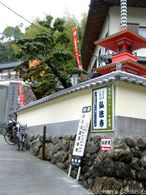 Anyway, at the temple, the ceremony was about to start.
Anyway, at the temple, the ceremony was about to start.
According to the newsletter article, this event was a sort of collaboration of Shinto and Buddhism rituals aiming at getting rid of troubles/ worries, and welcoming good luck, health and family safety. Many of you might find this strange, but the fact is that in Japan, the two religions -- Shinto and Buddhism -- uniquely co-exist.
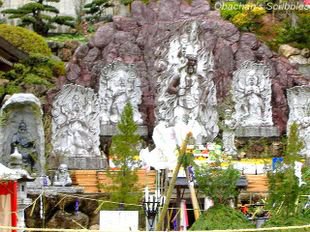 Ancient rulers of Japan imported and supported Buddhism enthusias- tically not only for its religious value but also for importing advanced culture and technology from abroad with the religion. They taught Japanese people that both Japanese gods and Buddha would cooperatively help and make them happy. So still today, most of regular Japanese households celebrate both Shinto and Buddhist ceremonies. (That’s what I think I understood from our history class in jr. high. I was not a good student, so corrections, please.)
Ancient rulers of Japan imported and supported Buddhism enthusias- tically not only for its religious value but also for importing advanced culture and technology from abroad with the religion. They taught Japanese people that both Japanese gods and Buddha would cooperatively help and make them happy. So still today, most of regular Japanese households celebrate both Shinto and Buddhist ceremonies. (That’s what I think I understood from our history class in jr. high. I was not a good student, so corrections, please.)
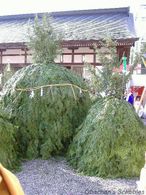

At the temple, branches of Japanese cypress were piled up in the center of a square, roped-off area near many Buddhist statues. After a while, Buddhist monks in colorful costumes, yamabushi (mountain priests?) with conch-shell horns and Shinto priests came into the square. There were kid priests, too.

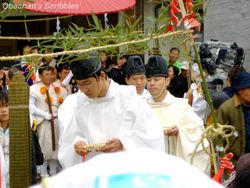

 Then a dialogue took place between the host mountain priest and mountain priests from a distant prefecture, waiting outside the square. The host asked the leader of the visitors questions to test their religious knowledge, and they were allowed into the square after the leader answered all the questions.
Then a dialogue took place between the host mountain priest and mountain priests from a distant prefecture, waiting outside the square. The host asked the leader of the visitors questions to test their religious knowledge, and they were allowed into the square after the leader answered all the questions.
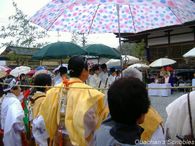 It was a chilly, cloudy day and it finally started raining in the middle of the ceremony!! Of course the ceremony went on and we had to use umbrellas or rain coats. Many of the attendants were elder people and I was worried that they might catch a cold.
It was a chilly, cloudy day and it finally started raining in the middle of the ceremony!! Of course the ceremony went on and we had to use umbrellas or rain coats. Many of the attendants were elder people and I was worried that they might catch a cold.
Some rituals were performed to chase the evils away and purify the area. After a guy showed a performance with chained sickles, four guys cut rolled rush mats facing four directions. That was supposed to slay the evils in north, south, east and west.
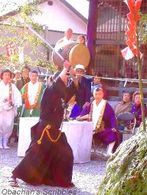
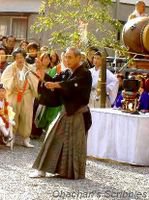
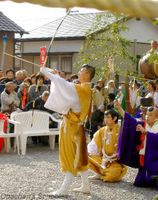
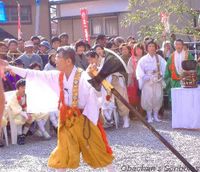
The arrow and the ax were also supposed to kill the evils and purify the area.
 Finally, they started burning the cypress branches!!
Finally, they started burning the cypress branches!!
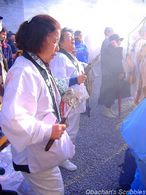 OMG, the smoke!! The audience in the front row including myself started coughing and tearing because of the thick smoke. But some enthusiastic visitors kept chanting in the front row. This smoke was supposed to purify us (and I was positive that any germs on/inside of me were smoldered to death.) ;P
OMG, the smoke!! The audience in the front row including myself started coughing and tearing because of the thick smoke. But some enthusiastic visitors kept chanting in the front row. This smoke was supposed to purify us (and I was positive that any germs on/inside of me were smoldered to death.) ;P
Then the cypress branches started burning with a big flame! Now we got so hot, even with the mountain priests standing in front of us throwing flat, long wood pieces into the fire. I assume those wood pieces had the visitors’ wishes written on, and they were burned so that the wishes would go up in the air with the smoke to reach someone above in heaven. This fire is also supposed to burn our worries and negative feelings such as jealous, greed and hatred.
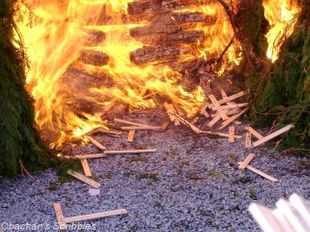 This reminded me of the "sweat lodge ceremony" that I attended when I was in Arizona more than 10 years ago. IIRC, they encouraged participants to take out the negative feelings onto the fire (or was it heated rocks or something?) burning in the shallow pit in the ground inside the sweat lodge. They said that the ancestors would come to the fire and take care of the negative feelings.
This reminded me of the "sweat lodge ceremony" that I attended when I was in Arizona more than 10 years ago. IIRC, they encouraged participants to take out the negative feelings onto the fire (or was it heated rocks or something?) burning in the shallow pit in the ground inside the sweat lodge. They said that the ancestors would come to the fire and take care of the negative feelings.
Western Psychology I studied in the States taught me the importance and technique of taking negative, “circular thinking” out of our system to be freed from it and be able to deal with it so that we can move forward. And now back in Japan, I see these people dealing with the negative side of human nature in this way, and the tradition has been handed down for hundreds of years…
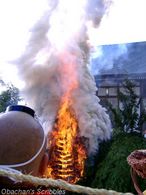 To me all these things seem to share the same, very basic and universal wisdom at their basis. Perhaps, we all shared the same wisdom from ancient times, and each culture has developed its own unique way of embodying and handing down the wisdom. Of course, this is an overly simplified view. I don’t mean to disrespect the differences. Yet I prefer seeing people in the world as “the same AND different,”and when I think about it, I feel much closer to all the people in the world, though I’m aware how naive this may sound...
To me all these things seem to share the same, very basic and universal wisdom at their basis. Perhaps, we all shared the same wisdom from ancient times, and each culture has developed its own unique way of embodying and handing down the wisdom. Of course, this is an overly simplified view. I don’t mean to disrespect the differences. Yet I prefer seeing people in the world as “the same AND different,”and when I think about it, I feel much closer to all the people in the world, though I’m aware how naive this may sound...
As the fire got smaller, the priests flattened the charcoals and ashes which were still hot. Now it was time for the “fire walking ritual.” I’ve seen mountain priests walking on fire like this on TV before, so I knew it was part of their training. Then to my surprise, I heard an announcement, “Those who want to participate in the fire-walking, please buy a gohei (paper ornament for Shinto ritual) and hold it in your hands.” What?! Do the visitors also walk on the hot charcoals in bear feet? You mean these grandmas and grandpas? I thought they would place something over the hot ashes for the regular people to walk on.


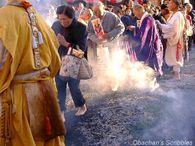 To my surprise, nothing was placed on the hot charcoals/ashes. First the priests, then the visitors --- grandmas, grandpas, younger people and even kids --- walked barefoot over still smoldering charcoals. I was really curious what it would feel like. No one seemed to have been injured, even elder people who could walk only slowly, so obviously it was safe. Then why not me?! But unfortunately I forgot to bring my wallet and couldn’t buy the gohei paper…
To my surprise, nothing was placed on the hot charcoals/ashes. First the priests, then the visitors --- grandmas, grandpas, younger people and even kids --- walked barefoot over still smoldering charcoals. I was really curious what it would feel like. No one seemed to have been injured, even elder people who could walk only slowly, so obviously it was safe. Then why not me?! But unfortunately I forgot to bring my wallet and couldn’t buy the gohei paper…
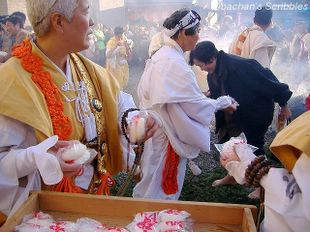
Rice cakes were given to those who finished fire-walking
So that day, everyone there including myself went through quite a bit of challenges. It was freezing cold to start with, and we got wet in the rain, then smoked, nearly roasted and finally frozen again by the cold wind. I was just happy that I didn’t get sick after coming home that day. I hope this fire-walking saved those grandpas and grandmas from getting sick after that challenging day. :)
I had read about this festival in a community newsletter, got interested, and checked the location of the temple on the map beforehand. It was not too far from where I live, so I decided to go by bicycle. As I went closer to the destination, I hated myself for not having paid more attention to the contours on the map. The temple was in a mountainous area, and the slope got steeper and steeper. Finally I realized that walking was much easier, so I pushed my bicycle and walked. The newsletter said “Take the steps from the main road to the temple.” I expected to go up from there, but actually the steps were ...


Yeah, right… there are steps indeed… The newsletter didn't lie. But...
What did I climb up the hill that much for ???
 Anyway, at the temple, the ceremony was about to start.
Anyway, at the temple, the ceremony was about to start.According to the newsletter article, this event was a sort of collaboration of Shinto and Buddhism rituals aiming at getting rid of troubles/ worries, and welcoming good luck, health and family safety. Many of you might find this strange, but the fact is that in Japan, the two religions -- Shinto and Buddhism -- uniquely co-exist.
 Ancient rulers of Japan imported and supported Buddhism enthusias- tically not only for its religious value but also for importing advanced culture and technology from abroad with the religion. They taught Japanese people that both Japanese gods and Buddha would cooperatively help and make them happy. So still today, most of regular Japanese households celebrate both Shinto and Buddhist ceremonies. (That’s what I think I understood from our history class in jr. high. I was not a good student, so corrections, please.)
Ancient rulers of Japan imported and supported Buddhism enthusias- tically not only for its religious value but also for importing advanced culture and technology from abroad with the religion. They taught Japanese people that both Japanese gods and Buddha would cooperatively help and make them happy. So still today, most of regular Japanese households celebrate both Shinto and Buddhist ceremonies. (That’s what I think I understood from our history class in jr. high. I was not a good student, so corrections, please.)

At the temple, branches of Japanese cypress were piled up in the center of a square, roped-off area near many Buddhist statues. After a while, Buddhist monks in colorful costumes, yamabushi (mountain priests?) with conch-shell horns and Shinto priests came into the square. There were kid priests, too.



 Then a dialogue took place between the host mountain priest and mountain priests from a distant prefecture, waiting outside the square. The host asked the leader of the visitors questions to test their religious knowledge, and they were allowed into the square after the leader answered all the questions.
Then a dialogue took place between the host mountain priest and mountain priests from a distant prefecture, waiting outside the square. The host asked the leader of the visitors questions to test their religious knowledge, and they were allowed into the square after the leader answered all the questions. It was a chilly, cloudy day and it finally started raining in the middle of the ceremony!! Of course the ceremony went on and we had to use umbrellas or rain coats. Many of the attendants were elder people and I was worried that they might catch a cold.
It was a chilly, cloudy day and it finally started raining in the middle of the ceremony!! Of course the ceremony went on and we had to use umbrellas or rain coats. Many of the attendants were elder people and I was worried that they might catch a cold.Some rituals were performed to chase the evils away and purify the area. After a guy showed a performance with chained sickles, four guys cut rolled rush mats facing four directions. That was supposed to slay the evils in north, south, east and west.




The arrow and the ax were also supposed to kill the evils and purify the area.
 Finally, they started burning the cypress branches!!
Finally, they started burning the cypress branches!! OMG, the smoke!! The audience in the front row including myself started coughing and tearing because of the thick smoke. But some enthusiastic visitors kept chanting in the front row. This smoke was supposed to purify us (and I was positive that any germs on/inside of me were smoldered to death.) ;P
OMG, the smoke!! The audience in the front row including myself started coughing and tearing because of the thick smoke. But some enthusiastic visitors kept chanting in the front row. This smoke was supposed to purify us (and I was positive that any germs on/inside of me were smoldered to death.) ;PThen the cypress branches started burning with a big flame! Now we got so hot, even with the mountain priests standing in front of us throwing flat, long wood pieces into the fire. I assume those wood pieces had the visitors’ wishes written on, and they were burned so that the wishes would go up in the air with the smoke to reach someone above in heaven. This fire is also supposed to burn our worries and negative feelings such as jealous, greed and hatred.
 This reminded me of the "sweat lodge ceremony" that I attended when I was in Arizona more than 10 years ago. IIRC, they encouraged participants to take out the negative feelings onto the fire (or was it heated rocks or something?) burning in the shallow pit in the ground inside the sweat lodge. They said that the ancestors would come to the fire and take care of the negative feelings.
This reminded me of the "sweat lodge ceremony" that I attended when I was in Arizona more than 10 years ago. IIRC, they encouraged participants to take out the negative feelings onto the fire (or was it heated rocks or something?) burning in the shallow pit in the ground inside the sweat lodge. They said that the ancestors would come to the fire and take care of the negative feelings.Western Psychology I studied in the States taught me the importance and technique of taking negative, “circular thinking” out of our system to be freed from it and be able to deal with it so that we can move forward. And now back in Japan, I see these people dealing with the negative side of human nature in this way, and the tradition has been handed down for hundreds of years…
 To me all these things seem to share the same, very basic and universal wisdom at their basis. Perhaps, we all shared the same wisdom from ancient times, and each culture has developed its own unique way of embodying and handing down the wisdom. Of course, this is an overly simplified view. I don’t mean to disrespect the differences. Yet I prefer seeing people in the world as “the same AND different,”and when I think about it, I feel much closer to all the people in the world, though I’m aware how naive this may sound...
To me all these things seem to share the same, very basic and universal wisdom at their basis. Perhaps, we all shared the same wisdom from ancient times, and each culture has developed its own unique way of embodying and handing down the wisdom. Of course, this is an overly simplified view. I don’t mean to disrespect the differences. Yet I prefer seeing people in the world as “the same AND different,”and when I think about it, I feel much closer to all the people in the world, though I’m aware how naive this may sound...As the fire got smaller, the priests flattened the charcoals and ashes which were still hot. Now it was time for the “fire walking ritual.” I’ve seen mountain priests walking on fire like this on TV before, so I knew it was part of their training. Then to my surprise, I heard an announcement, “Those who want to participate in the fire-walking, please buy a gohei (paper ornament for Shinto ritual) and hold it in your hands.” What?! Do the visitors also walk on the hot charcoals in bear feet? You mean these grandmas and grandpas? I thought they would place something over the hot ashes for the regular people to walk on.


 To my surprise, nothing was placed on the hot charcoals/ashes. First the priests, then the visitors --- grandmas, grandpas, younger people and even kids --- walked barefoot over still smoldering charcoals. I was really curious what it would feel like. No one seemed to have been injured, even elder people who could walk only slowly, so obviously it was safe. Then why not me?! But unfortunately I forgot to bring my wallet and couldn’t buy the gohei paper…
To my surprise, nothing was placed on the hot charcoals/ashes. First the priests, then the visitors --- grandmas, grandpas, younger people and even kids --- walked barefoot over still smoldering charcoals. I was really curious what it would feel like. No one seemed to have been injured, even elder people who could walk only slowly, so obviously it was safe. Then why not me?! But unfortunately I forgot to bring my wallet and couldn’t buy the gohei paper…
Rice cakes were given to those who finished fire-walking
So that day, everyone there including myself went through quite a bit of challenges. It was freezing cold to start with, and we got wet in the rain, then smoked, nearly roasted and finally frozen again by the cold wind. I was just happy that I didn’t get sick after coming home that day. I hope this fire-walking saved those grandpas and grandmas from getting sick after that challenging day. :)
posted by obachan, 12/09/2005 01:52:00 PM
7 Comments:
I love your site but it makes me miss Kochi alot, I have only been there twice but it feels like a second home(thanks to my wifes family and friends). My wife is a Kochi lady:) we both live in England at the moment but would like to live in Japan eventually but my Japanese is to poor to be able to find work yet:( have a wonderful new year, regards Ian
commented by  Ian, 12/12/2005 10:00 AM
Ian, 12/12/2005 10:00 AM
 Ian, 12/12/2005 10:00 AM
Ian, 12/12/2005 10:00 AM
Hi Ian,
So nice to hear from you. I'm glad that my post is helping some people remember Kochi. BTW, I think I saw you in Kochi in summer 2005, not when you were dancing in Yosakoi but in the city -- obiyamachi area or somewhere.
I hope you find a good work in Japan sometime soon.
Have a great New Year!
So nice to hear from you. I'm glad that my post is helping some people remember Kochi. BTW, I think I saw you in Kochi in summer 2005, not when you were dancing in Yosakoi but in the city -- obiyamachi area or somewhere.
I hope you find a good work in Japan sometime soon.
Have a great New Year!
Hi Obachan!
I agree with you about people being "the same but different". That's why I am so interested in studying other languages and especially linguistics. It's amazing how similar languages can be on a deep-down level while being totally different on the surface.
Thanks for the report on the festival. I'd be too afraid to try walking on the coals, I have to admit!
I agree with you about people being "the same but different". That's why I am so interested in studying other languages and especially linguistics. It's amazing how similar languages can be on a deep-down level while being totally different on the surface.
Thanks for the report on the festival. I'd be too afraid to try walking on the coals, I have to admit!
I don't know if this makes any sense or not, but the way I feel is that people are "the same AND different," just as someone might say "I'm a woman AND a wife AND a mother..."
Yes, that makes sense to me. And I think that's what makes the world so interesting....
Now, those are some steps. You are a very determined woman. Perhaps it is just as well you didn't have your wallet with you. Bicycling home with (possibly) singed feet does not sound to me to be a pleasant prospect. Pity you missed out on yet another mochi cake though.
Off to buy a Christmas tree, the hunt for the perfect one starts now.
Off to buy a Christmas tree, the hunt for the perfect one starts now.
commented by , 12/16/2005 3:18 AM
Jen
Yep, I definitely think so.
nokomarie
The participants --- including 80 or 90 year-old people --- washed their feet with cold water and went home. Can you imagine?
Honestly, I’ve been missing mochi cakes at festivals this autumn, so I’d probably be binge-eating them this coming New Year’s Day at my parents’ house.
Good luck with your Christmas tree hunting. :)
Yep, I definitely think so.
nokomarie
The participants --- including 80 or 90 year-old people --- washed their feet with cold water and went home. Can you imagine?
Honestly, I’ve been missing mochi cakes at festivals this autumn, so I’d probably be binge-eating them this coming New Year’s Day at my parents’ house.
Good luck with your Christmas tree hunting. :)



